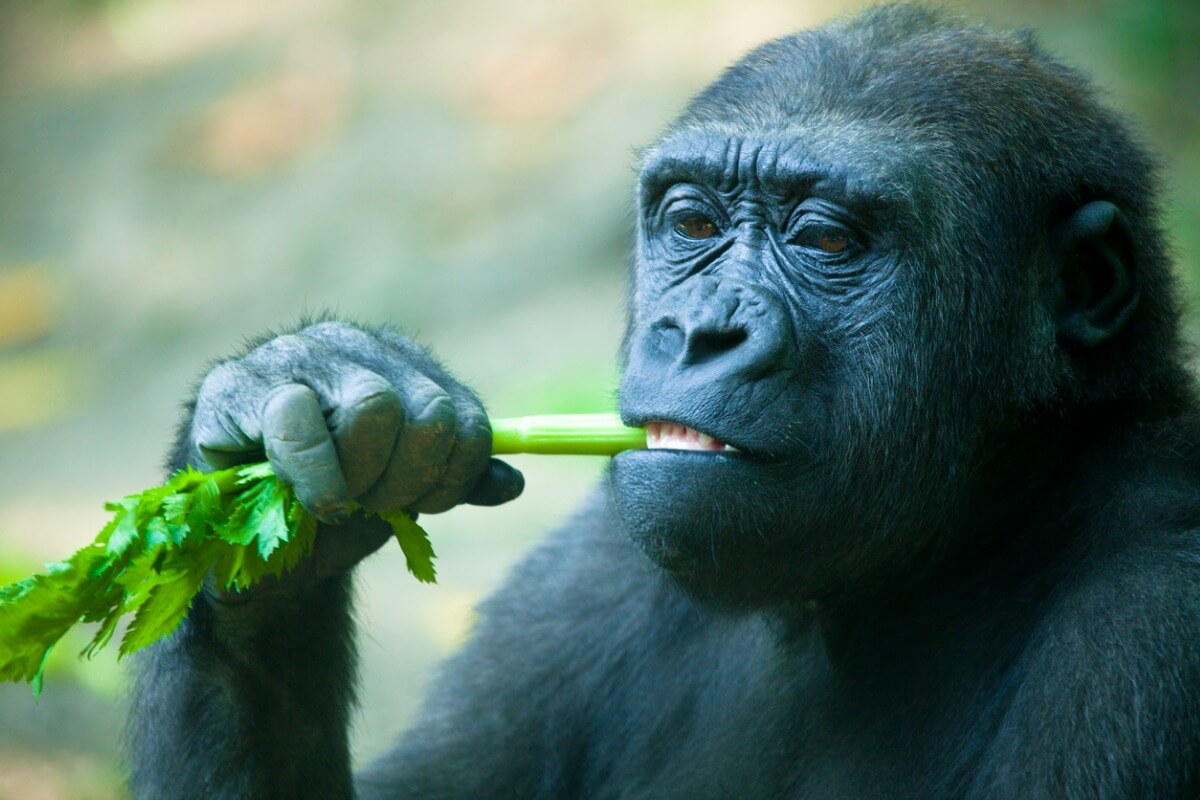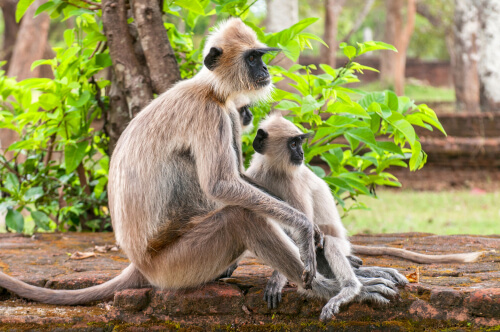Endangered Primates of the World


Written and verified by the biologist Elsa M. de Arribas
A headline that you could easily read in any newspaper or magazine is the following: “A large number of the world’s primates are in danger of extinction”. This news isn’t recent, and, unfortunately, the number of endangered primates that make up this list is increasing all the time.
From large primates such as gorillas and chimpanzees, to smaller ones such as tarsiers or lemurs. It’s estimated that 60% of primate species are in danger of extinction. The main cause is human action on their habitat, as well as illegal hunting and trade.
Endangered primates of the world
Currently, the number of endangered primates is 512, which corresponds to 60%. According to studies such as the one carried out by Estrada and collaborators, world primate populations have been deeply affected by different human actions.
Not only are 60% seriously endangered, but around 75% are in decline. Human actions responsible for this situation include the following:
- Illegal trade and hunting: unfortunately, the capture of these animals for private entertainment, as pets or for the fur industry, causes population decline.
- Deforestation.
- Oil extraction.
- Habitat loss: the expansion of farmland, as well as for housing construction or grazing, has had a negative influence by reducing the habitat available for these species.
This study covers primate habitats on the African continent, as well as in South and Southeast Asian countries, along with some countries with tropical climates. According to the authors, countries that host primate species have a much lower GDP (Gross Domestic Product) and food security than the main importing and exporting nations.
Greening of trade
The response of most of these countries has been to expand their farmland and agriculture, among other sectors. This has had a negative impact on the native primate populations of these countries. Therefore, the authors suggest a restructuring of the country’s environmental models. To this end, they use the term “greening”, which is based on global proposals such as:
- A diet with low meat consumption. It would reduce the need for agricultural space.
- Reduced consumption of oilseeds.
- Reduced use of wood, fossil fuels, metals, or precious stones from the tropics.
- Joint action to promote trade with prices accessible to all social groups.
- Preserving nature and the species that live in it.
Basically, they can all be summed up as reducing the consumption of unnecessary products and thus protecting the habitat of primates. By reducing space requirements, animals would be able to survive in their habitats without pressure from human actions.
Examples of endangered primates in the world
The following are some examples of primate species that will become extinct in the near future if the situation they find themselves in isn’t altered. Specifically, We’ll briefly explain the situation regarding 3 of the 84 species on the IUCN (International Union for Conservation of Nature) Red List of Critically Endangered species.
Gorilla gorilla
Native to the Congo and Gabon regions, Gorilla gorilla gorilla populations have suffered a significant loss of specimens in recent years. The main reasons for the endangerment of the western gorilla range from habitat encroachment and the creation of roads crossing the forest, to ecological (pollution) and biological (viral or prion-induced diseases) problems.
However, the government of the country has put forward various conservation plans that include habitat protection, population monitoring and follow-up, as well as investment in education. The latter aspect is essential, as if the people don’t understand the consequences of the loss of this and other species, they won’t be able to remedy the situation.

Pongo abelii
Another critically endangered primate is the Sumatran orangutan, which goes by the scientific name of Pongo abelii. Unfortunately, its population is also declining, as is the case with the other examples mentioned above.
Like its congener the gorilla, it also lives in forests, but in this case in Sumatra, in Asia, and is included in wildlife recovery plans. Among the main measures employed is the reintroduction of the species in habitats where it was absent.
Tarsius tumpara
Although it isn’t as well known as the two previous species, the Siau Island tarsia is in the same situation of decline as the other two species, the gorilla and the orangutan. In addition, this small species has been coveted as a pet, which has greatly increased the danger its specimens were exposed to.
After analyzing these three species, we carried out a quick search on the IUCN to find out the total extent of primate species classified in the “endangered” and “vulnerable” categories. It shows chilling figures, as 140 species are endangered and 115 species are vulnerable.
Even though some populations remain stable like the Hainan gibbon (Nomascus hainanus) or are even growing like the white-headed langur (T. poliocephalus), the vast majority show a population loss.

If the three categories are added together, we get a total of 339 species. In addition, the species classified as extinct, Xenothrix mcgregori or Jamaican monkey and Palaeopropithecus ingens or the great sloth lemur, have also been verified. A collective awareness and plan of action are needed to stop the disappearance of more primate species.
A headline that you could easily read in any newspaper or magazine is the following: “A large number of the world’s primates are in danger of extinction”. This news isn’t recent, and, unfortunately, the number of endangered primates that make up this list is increasing all the time.
From large primates such as gorillas and chimpanzees, to smaller ones such as tarsiers or lemurs. It’s estimated that 60% of primate species are in danger of extinction. The main cause is human action on their habitat, as well as illegal hunting and trade.
Endangered primates of the world
Currently, the number of endangered primates is 512, which corresponds to 60%. According to studies such as the one carried out by Estrada and collaborators, world primate populations have been deeply affected by different human actions.
Not only are 60% seriously endangered, but around 75% are in decline. Human actions responsible for this situation include the following:
- Illegal trade and hunting: unfortunately, the capture of these animals for private entertainment, as pets or for the fur industry, causes population decline.
- Deforestation.
- Oil extraction.
- Habitat loss: the expansion of farmland, as well as for housing construction or grazing, has had a negative influence by reducing the habitat available for these species.
This study covers primate habitats on the African continent, as well as in South and Southeast Asian countries, along with some countries with tropical climates. According to the authors, countries that host primate species have a much lower GDP (Gross Domestic Product) and food security than the main importing and exporting nations.
Greening of trade
The response of most of these countries has been to expand their farmland and agriculture, among other sectors. This has had a negative impact on the native primate populations of these countries. Therefore, the authors suggest a restructuring of the country’s environmental models. To this end, they use the term “greening”, which is based on global proposals such as:
- A diet with low meat consumption. It would reduce the need for agricultural space.
- Reduced consumption of oilseeds.
- Reduced use of wood, fossil fuels, metals, or precious stones from the tropics.
- Joint action to promote trade with prices accessible to all social groups.
- Preserving nature and the species that live in it.
Basically, they can all be summed up as reducing the consumption of unnecessary products and thus protecting the habitat of primates. By reducing space requirements, animals would be able to survive in their habitats without pressure from human actions.
Examples of endangered primates in the world
The following are some examples of primate species that will become extinct in the near future if the situation they find themselves in isn’t altered. Specifically, We’ll briefly explain the situation regarding 3 of the 84 species on the IUCN (International Union for Conservation of Nature) Red List of Critically Endangered species.
Gorilla gorilla
Native to the Congo and Gabon regions, Gorilla gorilla gorilla populations have suffered a significant loss of specimens in recent years. The main reasons for the endangerment of the western gorilla range from habitat encroachment and the creation of roads crossing the forest, to ecological (pollution) and biological (viral or prion-induced diseases) problems.
However, the government of the country has put forward various conservation plans that include habitat protection, population monitoring and follow-up, as well as investment in education. The latter aspect is essential, as if the people don’t understand the consequences of the loss of this and other species, they won’t be able to remedy the situation.

Pongo abelii
Another critically endangered primate is the Sumatran orangutan, which goes by the scientific name of Pongo abelii. Unfortunately, its population is also declining, as is the case with the other examples mentioned above.
Like its congener the gorilla, it also lives in forests, but in this case in Sumatra, in Asia, and is included in wildlife recovery plans. Among the main measures employed is the reintroduction of the species in habitats where it was absent.
Tarsius tumpara
Although it isn’t as well known as the two previous species, the Siau Island tarsia is in the same situation of decline as the other two species, the gorilla and the orangutan. In addition, this small species has been coveted as a pet, which has greatly increased the danger its specimens were exposed to.
After analyzing these three species, we carried out a quick search on the IUCN to find out the total extent of primate species classified in the “endangered” and “vulnerable” categories. It shows chilling figures, as 140 species are endangered and 115 species are vulnerable.
Even though some populations remain stable like the Hainan gibbon (Nomascus hainanus) or are even growing like the white-headed langur (T. poliocephalus), the vast majority show a population loss.

If the three categories are added together, we get a total of 339 species. In addition, the species classified as extinct, Xenothrix mcgregori or Jamaican monkey and Palaeopropithecus ingens or the great sloth lemur, have also been verified. A collective awareness and plan of action are needed to stop the disappearance of more primate species.
All cited sources were thoroughly reviewed by our team to ensure their quality, reliability, currency, and validity. The bibliography of this article was considered reliable and of academic or scientific accuracy.
- Estrada, A., Garber, P. A., & Chaudhary, A. (2019). Expanding global commodities trade and consumption place the world’s primates at risk of extinction. PeerJ, 7, e7068. https://peerj.com/articles/7068/
- The Critically Endangered Primates Species. (2021). IUCN Red List of Threatened Species. https://www.iucnredlist.org/search/grid?query=primates&searchType=species
- Maisels, F., Bergl, R.A. & Williamson, E.A. 2018. Gorilla gorilla (amended version of 2016 assessment). The IUCN Red List of Threatened Species 2018: e.T9404A136250858. https://dx.doi.org/10.2305/IUCN.UK.2018-2.RLTS.T9404A136250858.en. Downloaded on 17 June 2021.
- Singleton, I., Wich , S.A., Nowak, M., Usher, G. & Utami-Atmoko, S.S. 2017. Pongo abelii (errata version published in 2018). The IUCN Red List of Threatened Species 2017: e.T121097935A123797627. https://dx.doi.org/10.2305/IUCN.UK.2017-3.RLTS.T121097935A115575085.en. Downloaded on 17 June 2021.
- Shekelle, M & Salim, A. 2020. Tarsius tumpara. The IUCN Red List of Threatened Species 2020: e.T179234A17977202. https://dx.doi.org/10.2305/IUCN.UK.2020-3.RLTS.T179234A17977202.en. Downloaded on 18 June 2021.
This text is provided for informational purposes only and does not replace consultation with a professional. If in doubt, consult your specialist.








